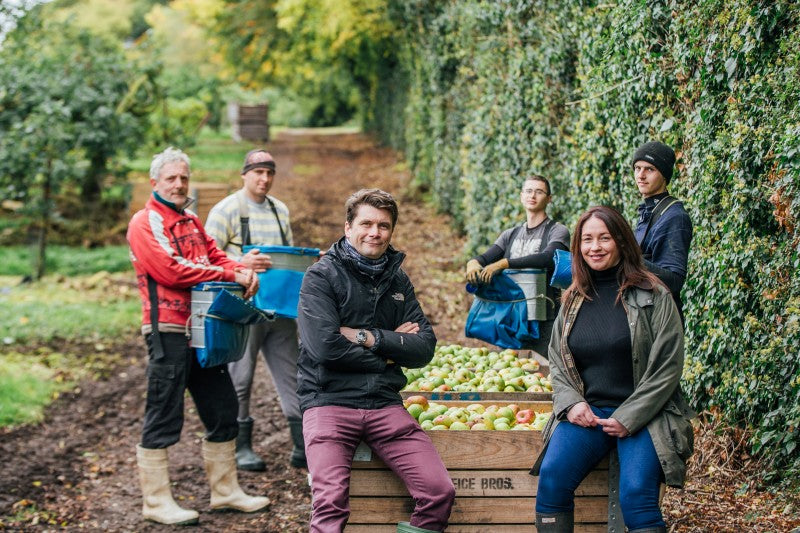The harvest is on everyone’s mind right now so when journalist Eleanor McGillie asked if she could come and learn the art of the craft Greg absolutely said yes. She travelled to our orchards here in County Armagh to try her hand at apple picking under Greg’s watchful eye. Have a read of Eleanor’s own experience of apple picking in our orchards:
THERE’S something mysterious about standing in the middle of 100 acres of orchards in the apple county of Ireland watching and listening as the harvest takes place all around.
It’s peaceful, lonely, exciting, heavy and beautiful all at once.
You can be there alone yet feel you are being watched. It’s a strange feeling if you have never been apple picking before. Apples thump to the ground in ones and twos, in front of you, behind you and suddenly you’re very conscious of your surroundings as you stand amidst such beauty.
I always had a taste for the fragrant apple.
Cider was my ever first tipple but what I never really understood was the journey of the apple. Nor did I ever understand the human interaction with the apple, the heritage, the art of the craft, the cider presses and who the people are who care enough to nurture the land.
County Armagh’s famous orchards are laden with fruit right now. The weather has not been as kind this year as it was last year but the smell of sweet apples fills the air. Harvest festivals are in the planning as people celebrate the fruits of hard labour and the great produce made from the crop.
When I was much younger, my memory of apples was making apple pies at this time of year in school but our apples contribute so much more today. There’s a craft cider market in Ireland which must be commended and apple varieties grown in County Armagh are key to this movement.
So I drove into the heart of the orchard county to unearth my own connection with the land.

Fifth generation apple grower Greg MacNeice, owner of Mac Ivors Cider Co, took me under his wing for the day. He welcomed me to his orchards on land opposite one of Northern Ireland’s much loved National Trust properties – Ardress House.
“Orchards are very peaceful places which are full of history,” explained Greg. “Where we are standing right now used to be a GAA pitch belonging to Annaghmore GAC where my father used to play all those years ago. The ground is low-lying and flat. But today it bears fruit which goes into making great tasting cider.
“We manage 100 acres of orchards and we have started planting another 10 acres. Cultivating the land is so important.
“We have been growing apples here at Ardress since 1855 but we have only been producing cider from here since 2011. My father always says we are caretakers of the land and we’re here to leave it in a better state than we found it and then pass it on to the next generation.
“We try and do that in everything that we do. We bring hives of bumblebees into the orchards and allow them to nest here.
“The scent and the smell of my childhood was apples and orchards and it still is to this day.”

Having jumped into a tractor we move from orchard to orchard feeling mesmerised by the huge crop.
“You can see how busy the crop is,” Greg pointed out.”We have so many different apple varieties growing and we tend to use about 14 different varieties in our blend. We now produce Traditional Dry Cider, Medium Cider and Plum and Ginger Cider – three ciders which are being sold all over Ireland, France, Germany and Italy. This year we also launched a Vintage Reserve Cider which is a beautiful product.
“The harvest is our busiest time. You can see how many apples there are everywhere. Some trees are better than others, some are younger and a lot of apples have fallen. They stay on the ground because they are bruised. It’s picking the apples which is an art in itself and picking the right apple at the right time.”
While touring the orchards, and learning about apple varieties, an older man comes out from the trees. He warmly greeted us with a wave and “cze??”. He’s Polish. He’s the father of a Polish family who travel from their homeland to Armagh every year just to pick apples. One suddenly became five – a whole family appear out from between the trees with apple baskets resting on their torsos, huge crates lined up to store their pick and greeting us with warm, welcoming smiles.
These are the apple pickers. And I think they could spot that I was not.

The movement of these people is fascinating. They spend their life interacting with crops. They pick apples in Armagh during the harvest, grapes in France, asparagus in England and olives in Italy.
It’s amazing to think of their contribution to the harvest process.
I couldn’t wait to pick apples. Perhaps it’s my love for cider that pulled me to the orchards to experience at least a small part of the cider making process.
I got dropped off with my apple basket and crate while Greg made his way back to the press. An eerie silence was broken every now and then by the thumping of falling apples. It’s strange, curious and very mysterious being in the middle of an orchard on your own.
But before Greg left me, he left me with a tip – picking is much better than pulling. Twisting the apple from the tree he said is less aggressive than pulling.
So pick I did. I soon learned why apple picking has been described as an art as apples are often attached – one big and one small. Trying to get the biggest without dropping the smallest is almost near to impossible. But I did my best to master the art and after a few hours I was finding myself feeling disappointed if a good apple dropped. I was almost apologetic.

But one thing is for sure, apple picking is a hard and heavy process. Apple pickers meander the trees, ducking and diving and reaching up high to pick the perfect apples. The care needed to pick one apple, and then place it gently in the cart so it doesn’t bruise, is hard to fathom until you have done it.
It’s a wonderful experience and spending time apple picking brought me closer to the harvest experience.
After a few hours of labour Greg returned to the orchard to take me back to the cider press.
On our way back to the yard he said: “These orchards tell a great story and we are very proud to be bringing the land’s history and heritage to life.
“What my dad Sammy said is right. We are caretakers of the land – something which we were awarded for recently at Blenheim Palace. The National Trust recognised the work of its tenant farmers and the work we do. They announced our Traditional Dry Cider and Medium Cider as a winner of the Trust’s Fine Farm Food Produce Award. It’s a great honour for everyone here that our work in the orchards is recognised in such a prestigious way. It puts these wonderful apples on the map.

“Caring for the land and the fruit it bears is part of a process. I often think back to those days where we were experimenting with old demijohns. Times have changed so much, the land is being cared for and there is a craft market which no-one could really have predicted.”
As we stand and watch the apples being brought into the yard in large crates Greg tells me that his mother is French. It’s undoubtedly clear he has been influenced by her heritage.
He said: “We always used to drink beautiful tasting cidre. It made perfect sense for me to explore the art of cider making. In my head I always wondered why we could drink beautiful cidre in France yet we didn’t have the equivalent in Ireland in spite of growing up surrounded by beautiful apple trees in the orchard county.
“I remember the day I decided to break out some old demijohns which had belonged to my uncle Peadar. Uncle Paedar was a real character. If you look at our bottles you will notice the red fox. Paedar is the fox in the branding.
“Mac Ivor was my granny’s maiden name and it was her who started growing the heritage varieties. It was important for me to bring her name back as an acknowledgment of what she started. My grandfather died quite young which left her with nine children and a farm to run.
“This gave us the opportunity for the brand to have a real personality and an authentic sense of place and of our apple growing heritage,” Greg said.
A lot has changed for this cider maker since he first experimented with old demijohns. His experiment is now a growing company which exports Irish craft ciders all over Ireland, France, Germany and Italy. But one thing which hasn’t changed is his unrelenting passion to care for the orchards which produce such an impressive crop and for the people who go on a journey with the apple through this fascinating process.
In spite of aches and pains, I am glad I got to experience apple picking first hand. I see why the harvest is a vital time of year. I feel such a pull to go back and do it all over again. The orchards on this land are beautiful, they offer protection for wildlife and they bear fruit for future generations.
What’s not to love?









